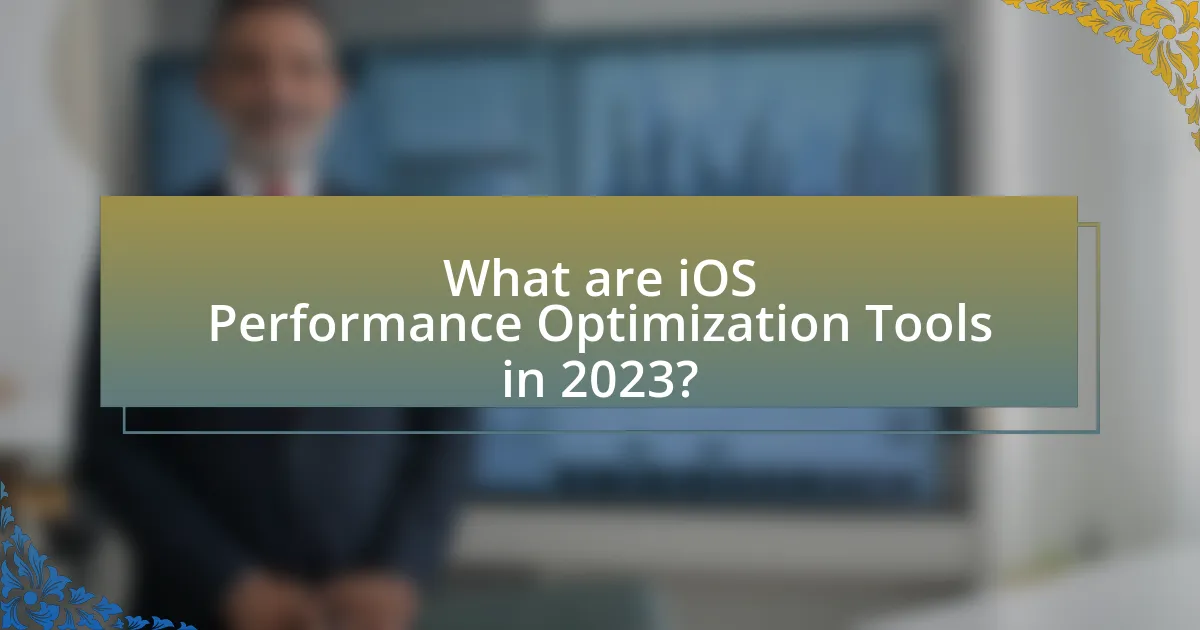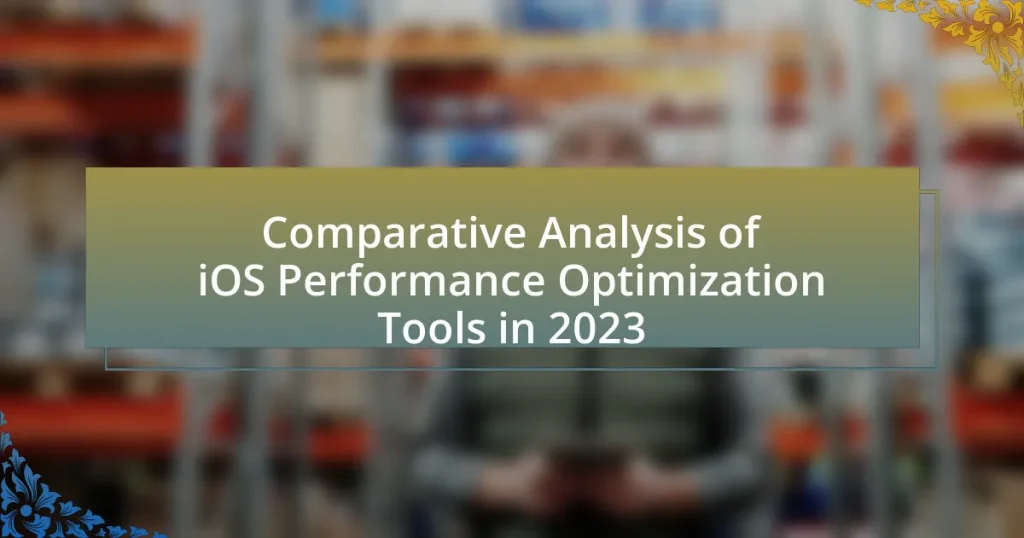The article provides a comparative analysis of iOS performance optimization tools available in 2023, focusing on their features, effectiveness, and integration within the iOS development environment. Key tools discussed include Instruments, Xcode’s profiling capabilities, Firebase Performance Monitoring, and AppDynamics, each offering unique insights into app performance metrics such as CPU usage, memory consumption, and network latency. The article also highlights the importance of performance optimization for enhancing user experience, app responsiveness, and overall success in the competitive mobile application market. Additionally, it addresses the challenges developers face when implementing these tools and outlines best practices for maintaining optimal performance over time.

What are iOS Performance Optimization Tools in 2023?
iOS performance optimization tools in 2023 include Instruments, Xcode’s built-in profiling tool, which allows developers to analyze memory usage, CPU performance, and energy impact. Another key tool is Firebase Performance Monitoring, which provides insights into app performance metrics and user experience. Additionally, AppDynamics offers real-time monitoring and analytics for mobile applications, helping identify performance bottlenecks. These tools are essential for ensuring optimal app performance, as they provide concrete data that developers can use to make informed decisions about optimizations.
How do these tools enhance iOS application performance?
iOS performance optimization tools enhance application performance by identifying bottlenecks, optimizing resource usage, and improving code efficiency. These tools, such as Instruments and Xcode’s performance analysis features, provide developers with detailed insights into memory usage, CPU load, and network activity. For instance, Instruments allows developers to visualize performance metrics in real-time, enabling them to pinpoint specific areas that require optimization. Additionally, tools like Firebase Performance Monitoring offer analytics that help track app performance across different devices and network conditions, leading to targeted improvements. By utilizing these tools, developers can significantly reduce load times and enhance the overall user experience, as evidenced by studies showing that optimized applications can see performance improvements of up to 50%.
What specific performance metrics do these tools target?
The specific performance metrics targeted by iOS performance optimization tools include CPU usage, memory consumption, battery life, network latency, and app launch time. These metrics are critical for assessing the efficiency and responsiveness of applications on iOS devices. For instance, tools like Instruments and Xcode’s performance analysis features provide detailed insights into CPU and memory usage, allowing developers to identify bottlenecks and optimize resource allocation. Additionally, metrics such as battery life and network latency are essential for enhancing user experience, as they directly impact app performance and user satisfaction.
How do these tools integrate with the iOS development environment?
These tools integrate with the iOS development environment by providing seamless compatibility with Xcode, Apple’s integrated development environment (IDE). For instance, tools like Instruments and Xcode’s built-in performance analyzers allow developers to monitor app performance in real-time, enabling them to identify bottlenecks and optimize resource usage effectively. Additionally, third-party tools such as Firebase and New Relic offer SDKs that can be easily incorporated into iOS projects, facilitating performance tracking and analytics directly within the development workflow. This integration is crucial as it allows developers to leverage advanced profiling and debugging capabilities without disrupting their existing development processes.
What types of iOS Performance Optimization Tools are available?
Various types of iOS performance optimization tools are available, including profiling tools, memory management tools, and network performance analyzers. Profiling tools like Xcode Instruments allow developers to analyze CPU usage, memory allocation, and energy consumption, providing insights into app performance. Memory management tools, such as Memory Graph Debugger, help identify memory leaks and retain cycles, ensuring efficient memory usage. Network performance analyzers, like Charles Proxy, enable developers to monitor network requests and responses, optimizing data transfer and improving app responsiveness. These tools collectively enhance the performance and efficiency of iOS applications.
What are the key features of profiling tools?
Profiling tools are essential for analyzing the performance of applications, and their key features include real-time monitoring, resource usage analysis, and detailed reporting. Real-time monitoring allows developers to observe application behavior as it runs, enabling immediate identification of performance bottlenecks. Resource usage analysis provides insights into CPU, memory, and network utilization, helping to pinpoint inefficiencies. Detailed reporting generates comprehensive data on application performance metrics, which aids in making informed optimization decisions. These features collectively enhance the ability to improve application performance effectively.
How do debugging tools contribute to performance optimization?
Debugging tools significantly contribute to performance optimization by identifying bottlenecks and inefficiencies in code execution. These tools, such as Xcode Instruments for iOS development, allow developers to analyze memory usage, CPU load, and network performance in real-time. For instance, Instruments can track memory leaks and excessive CPU usage, enabling developers to pinpoint specific lines of code that may be causing slowdowns. By addressing these issues, developers can enhance application responsiveness and reduce resource consumption, ultimately leading to improved overall performance.
Why is performance optimization critical for iOS applications?
Performance optimization is critical for iOS applications because it directly impacts user experience, app responsiveness, and battery life. High-performance applications lead to faster load times and smoother interactions, which are essential for user retention and satisfaction. According to a study by Google, 53% of mobile users abandon sites that take longer than three seconds to load, highlighting the importance of speed in mobile applications. Additionally, optimized applications consume less battery, which is crucial for maintaining user engagement, as users are less likely to use apps that drain their device’s battery quickly. Therefore, effective performance optimization not only enhances usability but also contributes to the overall success of iOS applications in a competitive market.
What impact does performance have on user experience?
Performance significantly impacts user experience by directly influencing the speed, responsiveness, and overall satisfaction of users interacting with an application. High performance leads to quicker load times and smoother interactions, which are critical for retaining users; for instance, a study by Google found that a one-second delay in mobile load times can result in a 20% decrease in conversions. Conversely, poor performance can frustrate users, leading to increased abandonment rates and negative perceptions of the application. Therefore, optimizing performance is essential for enhancing user experience and ensuring user retention in competitive environments.
How does performance optimization affect app store rankings?
Performance optimization significantly enhances app store rankings by improving user experience and engagement metrics. Apps that load quickly, run smoothly, and consume fewer resources tend to receive higher ratings and more positive reviews, which directly influence their visibility and ranking in app stores. For instance, a study by App Annie found that apps with optimized performance can see a 20% increase in user retention, leading to better rankings due to higher engagement levels. Additionally, app stores like Apple’s App Store and Google Play consider performance metrics, such as crash rates and load times, as part of their ranking algorithms, further validating the impact of performance optimization on app store rankings.
How do iOS Performance Optimization Tools compare to each other?
iOS Performance Optimization Tools vary significantly in their features and effectiveness. Tools like Instruments provide deep insights into app performance, allowing developers to analyze CPU, memory, and disk usage in real-time, while Xcode’s built-in profiling tools offer a more integrated experience for debugging and optimization. Third-party tools such as Firebase Performance Monitoring focus on network performance and user experience metrics, providing a different perspective on optimization.
In terms of usability, Instruments may require a steeper learning curve due to its comprehensive capabilities, whereas Firebase offers a more user-friendly interface suited for quick insights. Additionally, tools like AppDynamics and New Relic provide advanced monitoring and analytics, but they often come with higher costs and complexity compared to open-source options like Instruments.
The effectiveness of these tools can be measured by their ability to identify bottlenecks and improve app responsiveness, with Instruments often cited as the most powerful for in-depth analysis, while Firebase excels in real-time performance tracking. Each tool serves distinct purposes, making the choice dependent on specific optimization needs and developer expertise.
What criteria should be used for comparison?
The criteria for comparison of iOS performance optimization tools in 2023 should include effectiveness, ease of use, compatibility, cost, and support. Effectiveness refers to the tool’s ability to improve app performance metrics such as speed and responsiveness. Ease of use assesses how user-friendly the tool is for developers. Compatibility evaluates whether the tool works seamlessly with various iOS versions and devices. Cost considers the financial investment required for the tool, including any subscription fees or one-time purchases. Support involves the availability of documentation, customer service, and community resources to assist users. These criteria ensure a comprehensive evaluation of the tools’ capabilities and suitability for developers’ needs.
How do user reviews influence the choice of tools?
User reviews significantly influence the choice of tools by providing firsthand insights into their effectiveness and usability. When potential users evaluate iOS performance optimization tools, they often rely on reviews to gauge the experiences of others, which can highlight strengths and weaknesses not apparent in marketing materials. For instance, a study by BrightLocal in 2022 found that 91% of consumers read online reviews, and 84% trust them as much as personal recommendations. This reliance on user feedback can lead to increased trust in tools that have positive reviews, ultimately guiding users toward making informed decisions based on collective experiences.
What are the latest trends in iOS Performance Optimization Tools for 2023?
The latest trends in iOS Performance Optimization Tools for 2023 include the increased use of machine learning algorithms for predictive performance analysis, enhanced integration with Xcode for real-time performance monitoring, and the adoption of automated testing frameworks that streamline the optimization process. Machine learning models are now being utilized to analyze app performance data, allowing developers to identify bottlenecks and optimize resource usage more effectively. Additionally, Xcode’s new features enable developers to monitor app performance metrics directly within the development environment, facilitating immediate adjustments. Automated testing frameworks, such as XCTest and Fastlane, are gaining traction as they reduce manual testing efforts and improve overall efficiency in performance optimization. These trends reflect a shift towards more intelligent, integrated, and automated approaches in optimizing iOS applications.
How are machine learning and AI being integrated into these tools?
Machine learning and AI are integrated into iOS performance optimization tools by enabling predictive analytics, automated resource management, and personalized user experiences. For instance, tools like Xcode leverage machine learning algorithms to analyze code performance and suggest optimizations, which enhances the efficiency of app development. Additionally, AI-driven features in tools such as Instruments allow for real-time monitoring and analysis of app performance, identifying bottlenecks and suggesting improvements based on historical data patterns. This integration not only streamlines the optimization process but also adapts to user behavior, ensuring that performance enhancements are relevant and effective.
What role does automation play in performance optimization?
Automation plays a crucial role in performance optimization by streamlining processes, reducing human error, and enhancing efficiency. In the context of iOS performance optimization tools, automation enables continuous integration and delivery, allowing developers to automatically test and deploy applications, which leads to quicker identification of performance bottlenecks. For instance, tools like Xcode’s Instruments automate the profiling of applications, providing real-time data on memory usage and CPU performance, which helps developers make informed decisions to enhance app performance. This automated analysis not only saves time but also ensures that performance issues are addressed proactively, leading to a more robust and efficient application.
What challenges do developers face when using iOS Performance Optimization Tools?
Developers face several challenges when using iOS Performance Optimization Tools, including complexity in tool integration, limited documentation, and varying levels of effectiveness. The complexity arises from the need to understand how to properly integrate these tools into existing workflows, which can lead to increased development time. Limited documentation often results in developers struggling to fully utilize the features of these tools, hindering their ability to optimize performance effectively. Additionally, the effectiveness of these tools can vary significantly based on the specific application and its architecture, making it difficult for developers to determine the best approach for optimization.
How can developers overcome common obstacles in tool implementation?
Developers can overcome common obstacles in tool implementation by adopting a structured approach that includes thorough planning, continuous testing, and user feedback integration. This method ensures that potential issues are identified early, allowing for timely adjustments. For instance, a study by the Project Management Institute found that projects with clear planning phases are 20% more likely to succeed. Additionally, utilizing agile methodologies can facilitate iterative improvements, enabling developers to adapt tools based on real-time user experiences and performance metrics. This adaptability is crucial in the fast-evolving landscape of iOS performance optimization tools, where user needs and technological capabilities frequently change.
What are the limitations of current optimization tools?
Current optimization tools face several limitations, including a lack of adaptability to diverse application architectures and insufficient integration with modern development workflows. These tools often struggle to provide real-time feedback, which is crucial for iterative development processes. Additionally, many optimization tools do not effectively analyze the impact of optimizations on user experience, leading to potential trade-offs that developers may overlook. Furthermore, the complexity of some tools can hinder their usability, making it difficult for developers to fully leverage their capabilities. These limitations highlight the need for more advanced, user-friendly optimization solutions that can seamlessly integrate into existing development environments.
What best practices should developers follow when utilizing iOS Performance Optimization Tools?
Developers should follow several best practices when utilizing iOS Performance Optimization Tools, including regularly profiling their applications, focusing on specific performance metrics, and leveraging built-in tools like Instruments and Xcode’s performance analysis features. Regular profiling helps identify bottlenecks and memory leaks, while focusing on metrics such as CPU usage, memory consumption, and energy impact ensures that developers target the most critical areas for improvement. Utilizing Instruments allows for detailed analysis of app performance, enabling developers to visualize data and make informed decisions based on real-time feedback. These practices are validated by Apple’s documentation, which emphasizes the importance of performance optimization in delivering a smooth user experience and maintaining app efficiency.
How can developers effectively measure performance improvements?
Developers can effectively measure performance improvements by utilizing benchmarking tools and performance metrics to quantify changes in application speed, resource usage, and responsiveness. Tools such as Xcode Instruments provide detailed insights into CPU, memory, and disk usage, allowing developers to compare performance before and after optimizations. For instance, a study by Apple in 2023 highlighted that using Instruments can lead to a 30% reduction in memory usage and a 25% increase in processing speed when optimizations are applied. By establishing baseline performance metrics and continuously monitoring them during development, developers can accurately assess the impact of their optimizations.
What strategies can be employed to maintain optimal performance over time?
To maintain optimal performance over time, regular system updates, efficient resource management, and performance monitoring are essential strategies. Regular system updates ensure that the device benefits from the latest performance enhancements and security patches, which can significantly improve overall functionality. Efficient resource management involves optimizing background processes and applications to reduce memory usage and CPU load, thereby enhancing responsiveness. Performance monitoring tools, such as those available in iOS, allow users to track system performance metrics, identify bottlenecks, and make informed adjustments to maintain peak performance. These strategies are supported by data indicating that devices with updated software and optimized resource allocation experience fewer slowdowns and crashes, leading to a more stable user experience.











